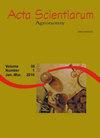Predator-prey relationship in the vertical distribution of mites on grapevines
IF 1.2
4区 农林科学
Q3 AGRONOMY
引用次数: 0
Abstract
Phytophagous mites can cause economic losses in many crops, including grapevines. The changes in their population levels may be associated with changes in the predator-prey relationship. Knowledge of the distribution of mites in plants is important for planning sampling strategies and facilitating control decisions. The aims of this study were to (i) evaluate the abundances of Tetranychus urticae (Tetranychidae) and Neoseiulus californicus (Phytoseiidae), and the correlations between them and environmental factors; (ii) determine their distribution on the top, middle, or base strata of the evaluated grapevines (Vitis vinifera, Chardonnay cultivar) and, additionally, report the first occurrence of damage caused by T. urticae in grapevine leaves in the state of Rio Grande do Sul, Southern Brazil. Sixteen samplings were conducted, divided between the 2018 and 2019 seasons. In each sampling, three leaves from the three strata of the plant (top, middle, and base) were collected from 20 plants, totaling 60 leaves per sampling. The predator-prey relationship and their association with environmental variables were evaluated with multivariate correlation, whereas the number of mites per plant leaf strata was compared using a generalized linear mixed model in R software. It was possible to observe the symptoms of damage caused by T. urticae attacks on grapevines in Southern Brazil, characterized by the presence of yellow spots and general yellowing of the vineyard. Our findings indicate that T. urticae and N. californicus individuals are strongly associated with each other regardless of the environmental variables, and such relationship occurs mainly on the lower strata (middle and base leaves) of grapevines. Thus, by taking into account the damage on the leaves of grapevines and the occurrence of T. urticae and N. californicus majorities on specific strata of these vineyards, we suggest that the lower strata of grapevines should be the priority targets for management strategies to control such mites.葡萄藤螨垂直分布的捕食-食饵关系
植食性螨虫会对包括葡萄藤在内的许多作物造成经济损失。它们数量水平的变化可能与捕食者-猎物关系的变化有关。了解螨虫在植物中的分布对于规划采样策略和促进控制决策非常重要。本研究的目的是(1)评价荨麻疹叶螨和加州新绥螨的丰度及其与环境因子的相关性;(ii)确定它们在被评估葡萄(葡萄品种,霞多丽品种)的上层、中层或底层的分布,此外,报告巴西南部南里奥格兰德州葡萄叶片中首次发生的由葡萄球菌造成的损害。在2018年和2019年的季节进行了16次采样。在每次采样中,从20株植物的三个层(顶部、中间和底部)中采集3片叶子,每次采样共60片叶子。利用多元相关分析评价了捕食者-猎物关系及其与环境变量的关系,利用广义线性混合模型在R软件中比较了每叶层螨的数量。在巴西南部,可以观察到荨麻疹对葡萄藤造成损害的症状,其特征是出现黄色斑点,葡萄园普遍变黄。研究结果表明,无论环境变量如何,荨麻疹与加州新绥螨个体之间存在很强的相关性,且这种相关性主要发生在葡萄树的下层(中叶和基叶)。因此,考虑到对葡萄叶片的损害以及葡萄叶螨和加州新螨在葡萄园特定层上的多数发生情况,我们建议应将下层葡萄作为控制此类螨的管理策略的优先目标。
本文章由计算机程序翻译,如有差异,请以英文原文为准。
求助全文
约1分钟内获得全文
求助全文
来源期刊

Acta Scientiarum. Agronomy.
Agricultural and Biological Sciences-Agronomy and Crop Science
CiteScore
2.40
自引率
0.00%
发文量
45
审稿时长
>12 weeks
期刊介绍:
The journal publishes original articles in all areas of Agronomy, including soil sciences, agricultural entomology, soil fertility and manuring, soil physics, physiology of cultivated plants, phytopathology, phyto-health, phytotechny, genesis, morphology and soil classification, management and conservation of soil, integrated management of plant pests, vegetal improvement, agricultural microbiology, agricultural parasitology, production and processing of seeds.
 求助内容:
求助内容: 应助结果提醒方式:
应助结果提醒方式:


